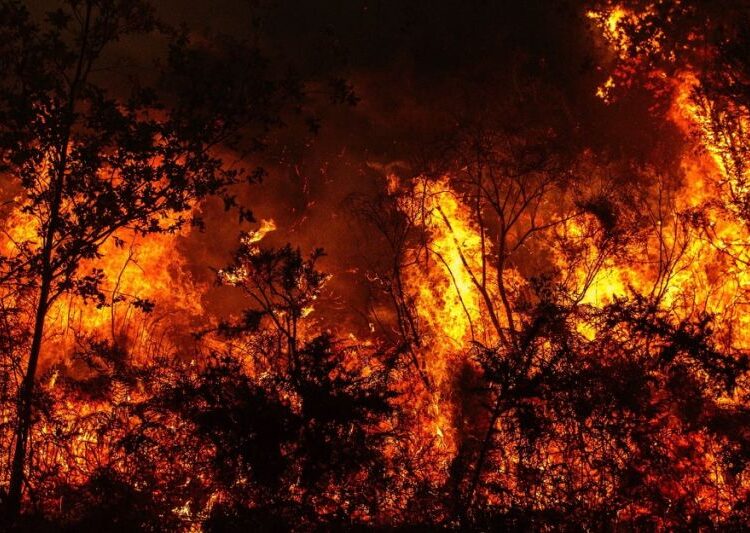With much of the US Southwest seeing explosive growth in wildfire events, air tanker and helicopter operators are quickly deploying assets, with the added challenge of keeping their pilots, mechanics, and other field crew safe under the ongoing coronavirus/COVID-19 pandemic according to American Helicopter Service and Aerial Firefighting Association.
With much of the US Southwest seeing explosive growth in wildfire events, air tanker and helicopter operators are quickly deploying assets, with the added challenge of keeping their pilots, mechanics, and other field crew safe under the ongoing coronavirus/COVID-19 pandemic.
“The USFS is relying much more heavily on airborne assets—both fixed and rotary wing--in order to minimize the need for large camps where firefighters are positioned in close proximity to each other, increasing the risk of contracting the coronavirus,” explained Dan Snyder, Chief Operating Officer of Neptune Aviation Services in Missoula, Montana.
Currently, five of Neptune Aviation Services’ BAe 146 tankers have been operating on multiple fires in Arizona, New Mexico and Utah since April, all under US Forest Service (USFS) contracts—one under call when needed, and four under exclusive use. Its four remaining tankers have subsequently come under call when needed contracts.
The USFS, Snyder also noted, is positioning firefighting aircraft nearer to active fires this year, with the intent of keeping them at those locations for the duration of the regional fire seasons. The aircraft, he explained, would then be relocated, as fire activity shifts to other parts of the country.
“Keeping redeployments to a minimum cuts the risk of coronavirus transmission because you are not moving people around as much,” Snyder pointed out.
Keeping aircraft in one location longer, Snyder observed, could also indicate that 2020 will be a more active fire season than the previous year. “The season’s early start in the western US actually came as no surprise. It’s in line with the current predictions of the National Interagency Fire Center,” he noted.
Rick Livingston, owner of Intermountain Helicopter in Sonora, California, which operates a single Bell 212, confirmed that aerial firefighting assets are trending toward longer duration where assigned. “We’ve seen that, this year. In fact, the USFS has been offering limited 90-day exclusive use contracts for operators of Type I and Type II helicopters,” he said. “I think we will see more of this, going forward.”
Livingston stressed that he is “definitely watching” the COVID-19 crisis. “Things are starting to open up, but who knows what will take place this summer,” he said. “Some of the overhaul shops are reopening, and people are starting to show up for work again. Our biggest issue was working with the FAA because more people were working from home, and it was a lot harder to get things done.”
Keith Saylor, Director of Commercial Operations for Columbia Helicopters, reported that the Portland, Oregon based operator has had a CH-47D helicopter working on the Bush Fire out of Phoenix, Arizona, since mid-June. “We also have a CH-47D positioned in Ely, Minnesota, and one in Cortez, Colorado,” he noted. “In addition, two of our Columbia Model 234s are currently based in Salmon, Idaho, and Oakridge, Colorado. All are under USFS call when needed contracts.”
According to Saylor, this year’s fire season is shaping up to be more active than normal, especially in the pacific northwest, where heavy rains have generated a considerable amount of fuel. As with other operators, he pointed out that preparations for this year’s fire season included COVID-19 protection.
“It was a great challenge—which we have met—to implement the safety measures for the coronavirus, per the CDC guidelines, Saylor stated. “We not only had to assure social distancing but the availability and use of personal protective equipment, along with establishing procedures for sterilizing our helicopters and support equipment. Also, more crew training has been shifted to video conferencing and web action.”
In addition, said Saylor, the company’s crews have been thoroughly trained to take protective measures in hotel rooms and other public places. “We’re using hand sanitizers, especially after coming into contact with high touch surfaces such as doorknobs and light switches,” he explained.
Timberline Helicopters of Sandpoint, Idaho, currently has a UH-60A on a USFS 90-day contract, based at Boise. “We have not been dispatched to an active fire yet, but we are ready with fully equipped aircraft and crew for when the call comes in,” said Travis Storro, the company’s Chief Operating Officer.
Storro said that for Timberline Helicopters, the primary impacts of the coronavirus have been logistical challenges, commercial flight availability, supply chain issues, and certain inefficiencies in order to maintain social distancing. “Still, we are fully staffed and ready to operate our fleet this summer to protect life and property.”
“COVID-19 has presented a formidable challenge to many businesses across the US economy, including the aerial firefighting industry,” said George Hill, Executive Director of the American Helicopter Services and Aerial Firefighting Association (AHSAFA). “Still, the aerial firefighting operators have continued to demonstrate 100-percent mission capable—even as the country continues to work through this global pandemic.”
Columbia Helicopters, Intermountain Helicopter, Neptune Aviation Services, and Timberline Helicopters are all members of AHSAFA, the trade association representing the privately operated aerial firefighting industry in Washington.






